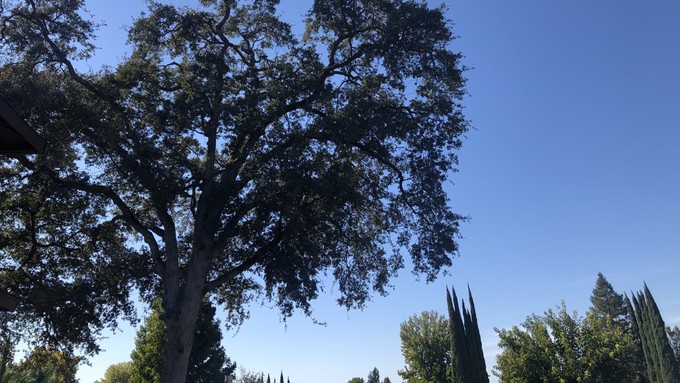
Now is the best time to plant trees in Sacramento; get some for free

Blue oaks like the one at left are popular drought-tolerant shade trees. Trees of all kinds help keep neighborhoods cool. Kathy Morrison
Shade: On a scorching summer day, it’s one of the most valuable assets for any home in the Sacramento region – and you can grow your own.
“It’s the difference between a livable summer and one that’s really stifling, not just uncomfortable but could threaten your life,” says Stephanie Robinson, communications and marketing manager for the Sacramento Tree Foundation. “If you lost a big shade tree recently, you really noticed the difference – especially this summer. You don’t realize until it’s gone how valuable shade is.”
Not only your own home is affected, she adds. “Shade trees keep your whole neighborhood cooler. Without trees, all that heat is absorbed by asphalt.”
Tree-lined streets lower the temperature of surrounding homes and improve the neighborhood’s quality of life, Robinson notes. “That’s why it’s one of the main priorities for our mission (at the foundation); plant more shade.”
SacTree volunteers tested their theories of shade tree impact on neighborhoods with a drive around Sacramento neighborhoods on a summer afternoon, Robinson says. “There was a 20-degree difference between the hottest and the shadiest neighborhoods at afternoon peak highs. That can be the difference between life and death for people without air conditioning.”
Now is the time to plan ahead and plant some shade. Fall is the best tree-planting season in the greater Sacramento area. While some trees have reputations as water hogs (specifically coastal redwoods), many other water-wise choices are available.
“If you’re re-doing your landscape, think trees first,” says Robinson. “It’s not just shade, but wildlife habitat. You can build trees into your water budget. It costs less than $3 a month to water a mature tree. A young tree costs only pennies. You can afford to invest in that shade.”
SacTree partners with the Sacramento Municipal Utility District (SMUD) to offer up to 10 free shade trees to customers. Since 1990, the program has planted more than 600,000 local trees. Details here: https://www.smud.org/en/Going-Green/Free-Shade-Trees
Participants contact SacTree and set up an appointment with a community forester. That program has expanded to include evergreens as well as trees that shade portions of a customer’s property other than their home.
“Shading landscape saves water because there’s less transpiration,” Robinson says. “There are many benefits of shade trees.”
Among the most popular water-wise shade trees for Sacramento landscapes are native oaks: Valley oak, interior live oak and blue oak.
“People love oaks,” says Robinson. “They’re sturdy, long-lived and (the deciduous varieties) offer a rainbow of fall color.”
Oaks take time to grow. A faster option is a zelkova; native to Japan, these trees can reach 60 feet in a hurry. “It’s a big, beautiful shade tree that grows fast,” Robinson says.
“Chinese pistache are still very popular, and the new cultivars are not as messy,” she adds. “Right now, people are very interested in trees that flower and support pollinators. The favorites are desert willow, vitex and strawberry trees.”
SacTree has many more suggestions in its “Shady 80,” its selection of best trees for Sacramento. This urban forest features dozens of water-wise choices: https://sactree.org/best-trees-for-sacramento/.
Comments
0 comments have been posted.Sacramento Digs Gardening to your inbox.
Food in My Back Yard Series
April 29: What's (already) wrong with my tomato plants?
April 22: Should you stock up on fertilizer? (Yes!)
April 15: Grow culinary herbs in containers
April 8: When to plant summer vegetables
April 1: Don't be fooled by these garden myths
March 25: Fertilizer tips: How to 'feed' your vegetables for healthy growth
March 18: Time to give vegetable seedlings some more space
March 11: Ways to win the fight against weeds
March 4: Potatoes from the garden
Feb. 25: Plant a fruit tree now -- for later
Feb. 18: How to squeeze more food into less space
Feb. 11: When to plant? Consider staggering your transplants
Feb. 4: Starting in seed starting
Sites We Like
Garden Checklist for week of May 4
Enjoy this spring weather – and get gardening!
* Plant, plant, plant! It’s prime planting season in the Sacramento area. Time to set out those tomato transplants along with peppers and eggplants. Pinch off any flowers on new transplants to make them concentrate on establishing roots instead of setting premature fruit.
* Direct-seed melons, cucumbers, summer squash, corn, radishes, pumpkins and annual herbs such as basil.
* Harvest cabbage, lettuce, peas and green onions.
* In the flower garden, direct-seed sunflowers, cosmos, salvia, zinnias, marigolds, celosia and asters. (You also can transplant seedlings for many of the same flowers.)
* Plant dahlia tubers. Other perennials to set out include verbena, coreopsis, coneflower and astilbe.
* Transplant petunias, marigolds and perennial flowers such as astilbe, columbine, coneflowers, coreopsis, dahlias, rudbeckia and verbena.
* Keep an eye out for slugs, snails, earwigs and aphids that want to dine on tender new growth.
* Feed summer bloomers with a balanced fertilizer.
* For continued bloom, cut off spent flowers on roses as well as other flowering plants.
* Add mulch to the garden to maintain moisture. Mulch also cuts down on weeds. But don’t let it mound around the stems or trunks of trees or shrubs. Leave about a 6-inch to 1-foot circle to avoid crown rot or other problems.